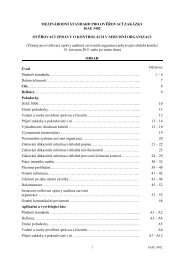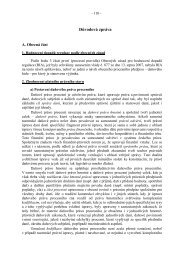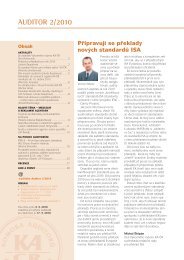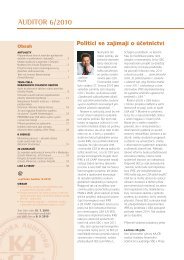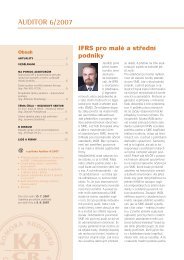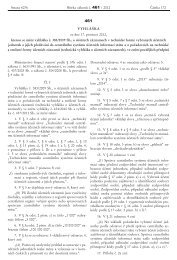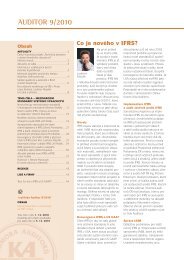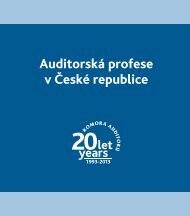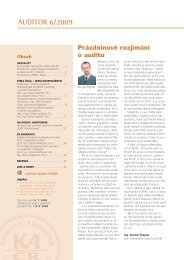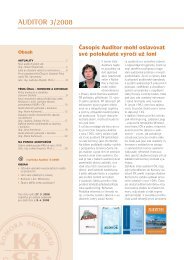Guide to Using International Standards on Auditing in - IFAC
Guide to Using International Standards on Auditing in - IFAC
Guide to Using International Standards on Auditing in - IFAC
You also want an ePaper? Increase the reach of your titles
YUMPU automatically turns print PDFs into web optimized ePapers that Google loves.
33<br />
<str<strong>on</strong>g>Guide</str<strong>on</strong>g> <str<strong>on</strong>g>to</str<strong>on</strong>g> <str<strong>on</strong>g>Us<strong>in</strong>g</str<strong>on</strong>g> <str<strong>on</strong>g>Internati<strong>on</strong>al</str<strong>on</strong>g> <str<strong>on</strong>g>Standards</str<strong>on</strong>g> <strong>on</strong> <strong>Audit<strong>in</strong>g</strong> <strong>in</strong> the Audits of Small- and Medium-Sized Entities Volume 1—Core C<strong>on</strong>cepts<br />
A team debrief<strong>in</strong>g meet<strong>in</strong>g (<str<strong>on</strong>g>to</str<strong>on</strong>g>wards or at the end of the fieldwork) is not a specific requirement of the ISAs,<br />
but can be useful for staff <str<strong>on</strong>g>to</str<strong>on</strong>g> discuss the audit f<strong>in</strong>d<strong>in</strong>gs, identify any <strong>in</strong>dicati<strong>on</strong>s of fraud, and determ<strong>in</strong>e the<br />
need (if any) <str<strong>on</strong>g>to</str<strong>on</strong>g> perform any further audit procedures.<br />
When all procedures have been performed and c<strong>on</strong>clusi<strong>on</strong>s reached:<br />
• Audit f<strong>in</strong>d<strong>in</strong>gs should be reported <str<strong>on</strong>g>to</str<strong>on</strong>g> management and those charged with governance; and<br />
• An audit op<strong>in</strong>i<strong>on</strong> should be formed and a decisi<strong>on</strong> made <strong>on</strong> the appropriate word<strong>in</strong>g for the audi<str<strong>on</strong>g>to</str<strong>on</strong>g>r’s report.<br />
3.4 Documentati<strong>on</strong><br />
Sufficient audit documentati<strong>on</strong> is required <str<strong>on</strong>g>to</str<strong>on</strong>g> enable an experienced audi<str<strong>on</strong>g>to</str<strong>on</strong>g>r, hav<strong>in</strong>g no previous c<strong>on</strong>necti<strong>on</strong><br />
with the audit, <str<strong>on</strong>g>to</str<strong>on</strong>g> understand:<br />
• The nature, tim<strong>in</strong>g, and extent of the audit procedures performed;<br />
• The results of perform<strong>in</strong>g those procedures and the audit evidence obta<strong>in</strong>ed; and<br />
• Significant matters aris<strong>in</strong>g dur<strong>in</strong>g the audit, the c<strong>on</strong>clusi<strong>on</strong>s reached there<strong>on</strong>; and significant<br />
professi<strong>on</strong>al judgments made <strong>in</strong> reach<strong>in</strong>g those c<strong>on</strong>clusi<strong>on</strong>s.<br />
Audit documentati<strong>on</strong> for a smaller entity is generally less extensive than that for the audit of a larger entity.<br />
For example, various aspects of the audit could be recorded <str<strong>on</strong>g>to</str<strong>on</strong>g>gether <strong>in</strong> a s<strong>in</strong>gle document, with crossreferences<br />
<str<strong>on</strong>g>to</str<strong>on</strong>g> support<strong>in</strong>g work<strong>in</strong>g papers, as appropriate.<br />
It is not necessary for the audi<str<strong>on</strong>g>to</str<strong>on</strong>g>r <str<strong>on</strong>g>to</str<strong>on</strong>g> document:<br />
• Every m<strong>in</strong>or matter c<strong>on</strong>sidered, or every professi<strong>on</strong>al judgment made, <strong>in</strong> an audit; and<br />
• Compliance with matters for which compliance is dem<strong>on</strong>strated by documents <strong>in</strong>cluded with<strong>in</strong> the<br />
audit file. For example, an audit plan <strong>on</strong> file dem<strong>on</strong>strates that the audit was planned, and a signed<br />
engagement letter dem<strong>on</strong>strates that the audi<str<strong>on</strong>g>to</str<strong>on</strong>g>r has agreed <str<strong>on</strong>g>to</str<strong>on</strong>g> the terms of the audit engagement.<br />
3.5 Benefits of the Risk-Based Audit<br />
Some of the benefits of the risk-based approach are summarized <strong>in</strong> the exhibit below.<br />
Exhibit 3.5-1<br />
Benefits<br />
Time Flexibility<br />
When Audit<br />
Work Needs<br />
<str<strong>on</strong>g>to</str<strong>on</strong>g> be Performed<br />
Descripti<strong>on</strong><br />
Risk assessment procedures can often be performed earlier <strong>in</strong> the entity’s fiscal<br />
period than was possible before risk-based audit<strong>in</strong>g was <strong>in</strong>troduced. Because risk<br />
assessment procedures do not <strong>in</strong>volve the detailed test<strong>in</strong>g of transacti<strong>on</strong>s and<br />
balances, they can be performed well before the period end, assum<strong>in</strong>g no major<br />
operati<strong>on</strong>al changes are anticipated. This can help <strong>in</strong> balanc<strong>in</strong>g the workload of<br />
audit staff more evenly throughout the period. It may provide the client with time <str<strong>on</strong>g>to</str<strong>on</strong>g><br />
resp<strong>on</strong>d <str<strong>on</strong>g>to</str<strong>on</strong>g> identified (and communicated) weaknesses <strong>in</strong> <strong>in</strong>ternal c<strong>on</strong>trol and other<br />
requests for assistance before the commencement of period-end audit fieldwork.<br />
However, where <strong>in</strong>terim f<strong>in</strong>ancial <strong>in</strong>formati<strong>on</strong> is not readily available, the analytical<br />
risk assessment procedures may have <str<strong>on</strong>g>to</str<strong>on</strong>g> be performed at a later date.




